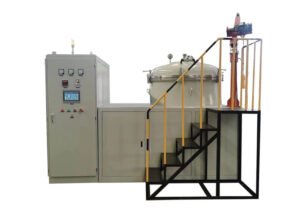Sintering is a key process in the production of cemented carbide. And it plays a decisive role in the performance of the final product. The sintering of cemented carbide can also be said to be the phenomenon or process that occurs when the workpiece is heated at an appropriate temperature and atmosphere. The sintering atmosphere in the sintering furnace is very important to ensure the normal progress of the sintering process and product quality. Therefore, it is necessary to understand the nature, function, influence, and control of the sintering atmosphere.
The role of the atmosphere in the sintering furnace
The sintering atmosphere refers to the atmosphere around the workpiece in the sintering furnace, and its main functions are as follows:
1. Prevent oxidation in the sintering furnace.
The most basic requirement is to protect the workpiece from oxidation during the sintering process. Therefore, we also call the sintering atmosphere a protective atmosphere.
2. Eliminate harmful impurities.
Cemented carbide raw materials Co, Ni, WC, TiC, (W, Ti)C, TaC, NbC, etc., are always mixed with some low-valent oxides that have not been completely reduced. The powder raw materials commonly used in the production of cemented carbide have a particle size of a few tenths of a micron to tens of microns and a large surface area. Its developed surface area stores high surface energy and has a strong adsorption capacity for gases and liquids. Therefore, it is very easy to absorb oxygen, water vapor, or other gases in the air or the environment. The mixture will also increase oxygen during the process of wet grinding, drying, and mixing of forming agents. Especially cobalt powder is easily oxidized and distributed on the particle surface as an oxide film. It must exclude these impurities O2, H2O, N2, H2, etc.
3. Control the carbon content of the alloy.
The carbon content range corresponding to the WC+γ two-phase region in the W-C-Co phase diagram of WC-Co alloy is very narrow. <10% Co alloy carbon content variation range <0.1%. WC-25% Co alloy is also less than 0.5%. Therefore, it must adopt various effective methods to make the final sintered product have the same carbon content as the original alloy powder and keep the distribution uniform.
Effect of Atmosphere on Wettability of Carbide
WC-Co cemented carbide is a typical liquid-phase sintered alloy. Whether it can successfully complete the liquid phase sintering, the primary condition is that the surface wettability of the liquid relative to the solid phase particles is better. Wettability greatly influences the densification, structure, and performance of cemented carbide. The surface tension (specific surface energy) determines the wettability of the solid and liquid phases and the two phases’ interfacial tension (interfacial energy). When fully wet, the wetting angle (or contact angle) θ=0°; when not wet, θ>90°; when partially wet, 0°<θ<90°. The wetting condition to be met in liquid phase sintering is the wetting angle θ<90°.
Studies have confirmed that the atmosphere in the sintering furnace can affect the wetting angle of iron group metals on carbides, as shown in the following table:
| Solid surface | Liquid Alloy | Temperature (℃) | Atmosphere | Contact Angle (θ) |
| WC | Co | 1500 | H2 | 0 |
| Co | 1420 | ~0 | ||
| Ni | 1500 | Vacuum | ~0 | |
| Ni | 1380 | ~0 | ||
| Fe | 1490 | ~0 | ||
| TiC | Ni | 1450 | H2 | 17 |
| Ni | 1450 | He | 32 | |
| Ni | 1450 | Vacuum | 30 | |
| Co | 1500 | H2 | 36 | |
| Co | 1500 | He | 39 | |
| Co | 1500 | Vacuum | 5 | |
| Fe | 1550 | H2 | 49 | |
| Fe | 1550 | He | 36 | |
| Fe | 1550 | Vacuum | 41 |
In general, the surface state of the powder has a great influence on wettability. The surface of the powder adsorbs gaseous impurities, or there are oxide films, oil stains, etc. These will reduce the wettability of the liquid phase to the solid phase particles. H2 and vacuum, especially vacuum, are beneficial to eliminate adsorbed gas and oxide film. And it improves the wettability of liquid to solid phase.











